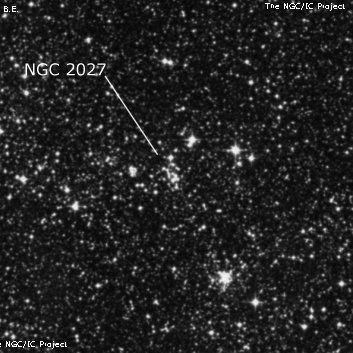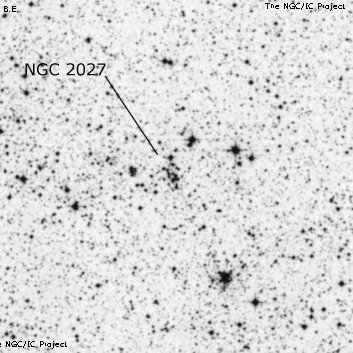NGC/IC Project Restoration Effort
(This is a very very beta version)
NGC2027


Basic Information
Location and Magnitude
Right Ascension: 5:34:59.8
Declination: -66:54:59
Constellation: DOR
Visual Magnitude: 11.9
Historic Information
Discoverer: Dunlop
Year of discovery: 1826
Discovery aperture: 9.0
Observational
Summary description: Cl, vL, Ri, st 9…11
Sub-type: OCL
Corwin's Notes
=====
NGC 2027. JH has three observations of this, and notes in each that "...fills
the whole field", "fills many fields", and "The field full of grouping stars."
In the first two observations, the stars are 9th magnitude and fainter, while
for the third, they are of 15th magnitude. As if this weren't enough to
confuse us, his positions scatter over an area three arcmin across.
The field is actually a rich part of the LMC, even more than a star cloud.
Any of the positions in the table would do for it, so I've taken the ESO
position as reasonably representative of what JH saw.
Just to make it even more interesting, NGC 2034 (which see) is a part of this,
too.
Steve's Notes
=====
NGC 2027
13.1" (2/20/04 - Costa Rica): NGC 2027 is at the west end of an interesting, elongated cluster or association (LH 84) extending ~4'x2' E-W in a crescent shape with NGC 2034 at the east end. At 105x, this condensed portion of the cloud contains a couple of dozen mag 12-13 star and a wide pair of mag 10 stars on the NW side. Although NGC 2027 is often applied to the small cluster S-L 592, Herschel's description applies to the entire association LH 84.
NGC 2027 is situated ~10' NW of the compact cluster NGC 2041 and near the east end of a huge, elongated star cloud known as the "Quadrant" (consisting of OB associations LH 65, LH 77 and LH 84) looping SW and the bending NW, extending 35' to NGC 2006 and 2002.



